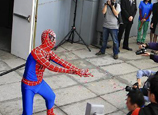
The earliest Chinese kites were made of wood and called Mu Yuan. Mu means wood and Yuan means sparrow hawk, a type of bird. So Mu Yuan means wooden sparrow hawk.The invention of paper did not escape the attention of kite makers and soon the kite was called Zhi Yuan. Zhi means paper, so Zhi Yuan means paper sparrow hawk. Kites were not just used for fun. They were also used for military purposes. There are historical records describing enormous kites, some of which are large enough to hife a man high in the air to observe enemy movements.
About 1,500 years ago, Emperor Wudi was surrounded in Nanjing by the rebel troops. He used a kite to send out an SOS for outside help. During the Tang Dynasty (618-907), people began to attach thin bamboo strips to kites. When the kite was high in the air, the wind would make these strips vibrate, producing a low-pitched twanging noise, very like that of the Zheng, a Chinese stringed instrument. Thereafter, another popular Chinese name for kite was Feng Zheng, which means “wind Zheng”.
In the Qing Dynasty (1644-1911), people would fly their kites as high as possible,then let go of the string. Off went the kite, taking with it bad luck and illness. Conversely, to pick up a kite lost or released by someone else could bring bad luck.
Some enthusiasts enjoy flying kites at night. They hang small colored lanterns on the string with candles burning inside. With dozens of kites up together, arc lines of flickering multicolored lights decorate the night sky.
Visitors should go to Tian'anmen Square to see kites of all shapes and sizes. The biggest could be a hundred meters long, made of a hundred sections to form a dragon or even a centipede. The Weifang Kite Festival held every April in East China's Shandong Province has become a major event, attracting thousands of tourists and kite flying competitors all over the world.

















 1,000-meter-long Spider Walk of Canton Tower opens
1,000-meter-long Spider Walk of Canton Tower opens


![]()
